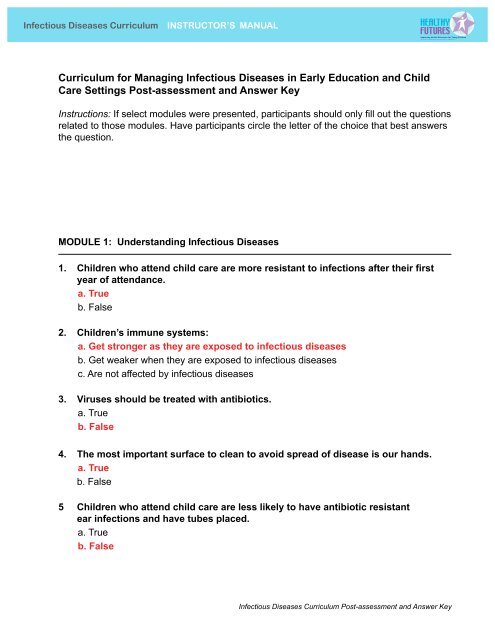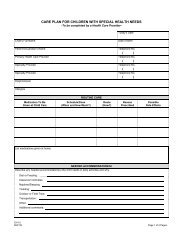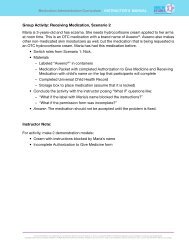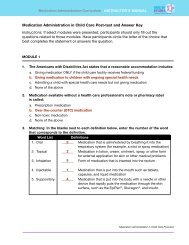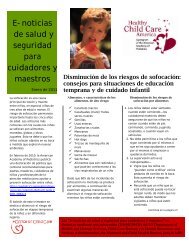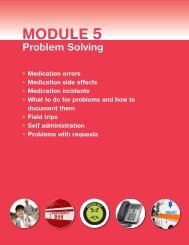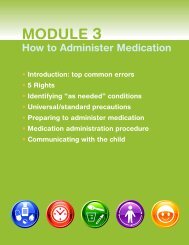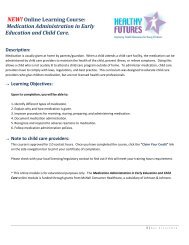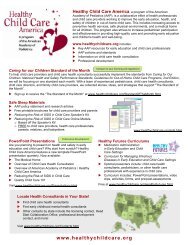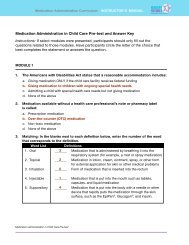Answer Key - Healthy Child Care America
Answer Key - Healthy Child Care America
Answer Key - Healthy Child Care America
Create successful ePaper yourself
Turn your PDF publications into a flip-book with our unique Google optimized e-Paper software.
Infectious Diseases Curriculum INSTRUCTOR’S MANUAL<br />
A program of the <strong>America</strong>n Academy of Pediatrics<br />
Curriculum for Managing Infectious Diseases in Early Education and <strong>Child</strong><br />
<strong>Care</strong> Settings Post-assessment and <strong>Answer</strong> <strong>Key</strong><br />
Instructions: If select modules were presented, participants should only fill out the questions<br />
related to those modules. Have participants circle the letter of the choice that best answers<br />
the question. Collect completed pre-assessments and use the business reply envelope<br />
provided in the Instructor’s Manual to return them to the <strong>America</strong>n Academy of Pediatrics<br />
(AAP). If you need additional envelopes, please call the AAP Early Education and <strong>Child</strong><br />
<strong>Care</strong> Initiatives at 888/227-5409.<br />
MODULE 1: Understanding Infectious Diseases<br />
1. <strong>Child</strong>ren who attend child care are more resistant to infections after their first<br />
year of attendance.<br />
a. True<br />
b. False<br />
2. <strong>Child</strong>ren’s immune systems:<br />
a. Get stronger as they are exposed to infectious diseases<br />
b. Get weaker when they are exposed to infectious diseases<br />
c. Are not affected by infectious diseases<br />
3. Viruses should be treated with antibiotics.<br />
a. True<br />
b. False<br />
4. The most important surface to clean to avoid spread of disease is our hands.<br />
a. True<br />
b. False<br />
5 <strong>Child</strong>ren who attend child care are less likely to have antibiotic resistant<br />
ear infections and have tubes placed.<br />
a. True<br />
b. False<br />
Infectious Diseases Curriculum Post-assessment and <strong>Answer</strong> <strong>Key</strong>
Infectious Diseases Curriculum INSTRUCTOR’S MANUAL<br />
A program of the <strong>America</strong>n Academy of Pediatrics<br />
MODULE 2: Preventing Infectious Diseases<br />
6. Which of the following is the best answer for how to reduce the number of germs<br />
in child care settings<br />
a. Circulate fresh outdoor air, use right-size flushing toilets, wash hands, and<br />
clean and sanitize surfaces that have been in contact with body fluids<br />
b. Clean and sanitize eating and diaper/underwear changing surfaces before and<br />
after each use, wash hands with antibacterial soap, and use germ-killing aerosol<br />
sprays to remove odors<br />
c. Wear disposable gloves to change diapers; serve and prepare food and clean<br />
up blood; and teach everyone to cover their mouths with their hands when they<br />
sneeze or cough<br />
d. Quickly remove children who seem sick from the facility and do not allow them to<br />
return until they have a note from a health care professional that says they are well<br />
7. Mixing children from different groups together when staffing is short in the<br />
morning and late afternoon spreads infection from group to group.<br />
a. True<br />
b. False<br />
MODULE 3: Recognizing and Managing Infectious Diseases<br />
8. A note from a child’s health care professional to return to child care after an<br />
illness is not necessary for children who act and feel well.<br />
a. True<br />
b. False<br />
9. The daily health check is performed:<br />
a. When the parent is transferring care of the child to the care of facility staff<br />
b. When the child leaves the facility to go on a field trip or has a new caregiver<br />
c. When the caregiver notices that a child has symptoms of illness<br />
d. A and C<br />
10. Before the child actually starts receiving care in the program, child care staff<br />
should discuss the following with parents:<br />
a. The program’s policy on caring for ill children<br />
b. Parent’s alternative care plans for child illness<br />
c. Who makes the final decision about whether an ill child can be in child care<br />
d. All of the above<br />
Infectious Diseases Curriculum Post-assessment and <strong>Answer</strong> <strong>Key</strong>
Infectious Diseases Curriculum INSTRUCTOR’S MANUAL<br />
A program of the <strong>America</strong>n Academy of Pediatrics<br />
11. <strong>Child</strong>ren should be excluded (sent home) from child care if they (Choose all the<br />
answers that apply):<br />
a. Have a fever<br />
b. Cannot participate in activities<br />
c. Require more care than can be provided in child care<br />
d. Have a condition that the health department says requires exclusion<br />
e. Have any diarrhea<br />
12. To care for an ill child, caregivers should (Choose all answers that apply):<br />
a. Adapt activities to the activity level of the ill child<br />
b. Provide extra attention to the ill child<br />
c. Inform parents of new symptoms by phone and use the symptom record<br />
to document the child’s status<br />
d. Isolate the ill child in the director’s office<br />
13. The goal of exclusion is to:<br />
a. Provide a setting where the child can recover more easily<br />
b. Prevent other children from getting fever<br />
c. Keep certain specific diseases from spreading through the child care site<br />
d. A and C<br />
e. None of the above<br />
Infectious Diseases Curriculum Post-assessment and <strong>Answer</strong> <strong>Key</strong>


